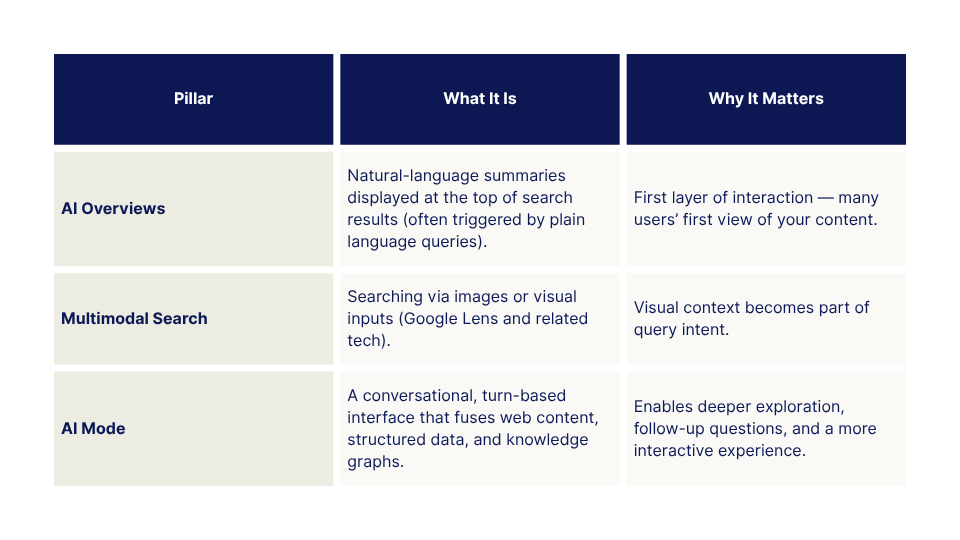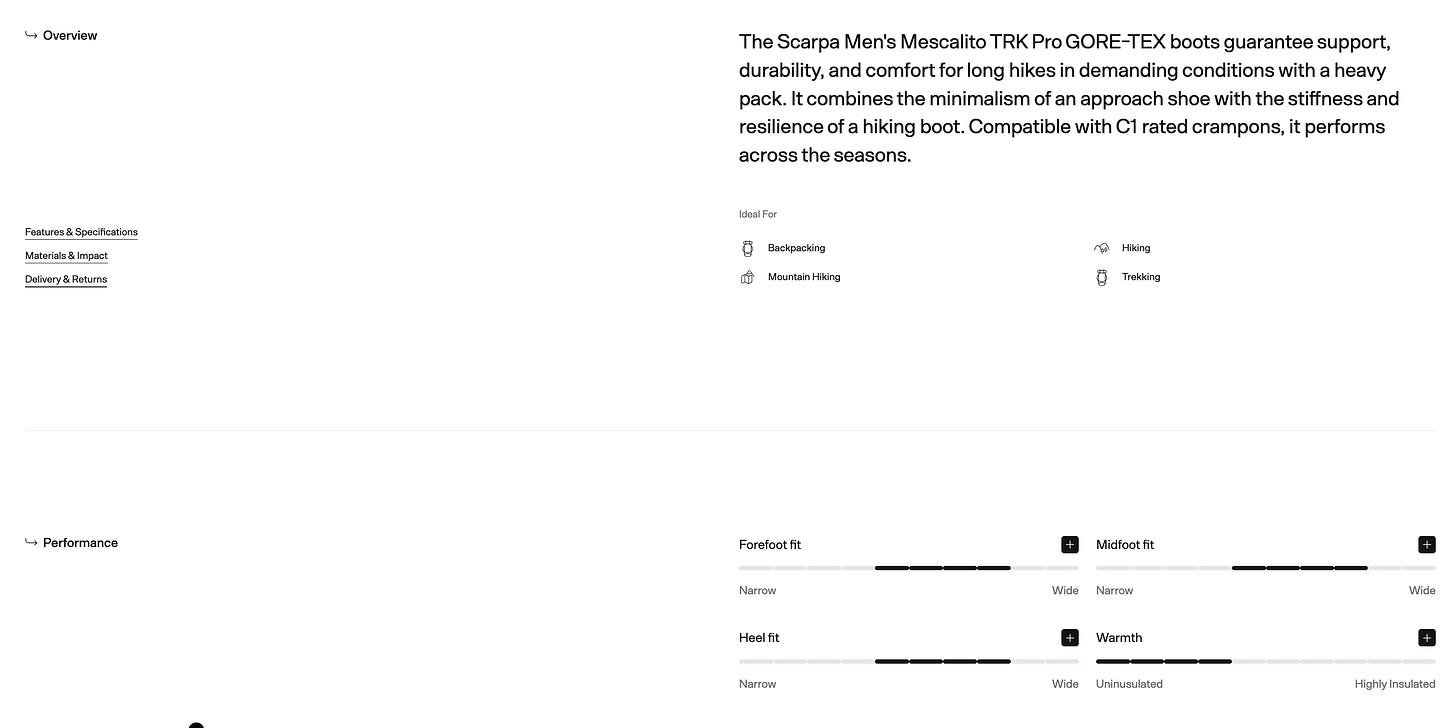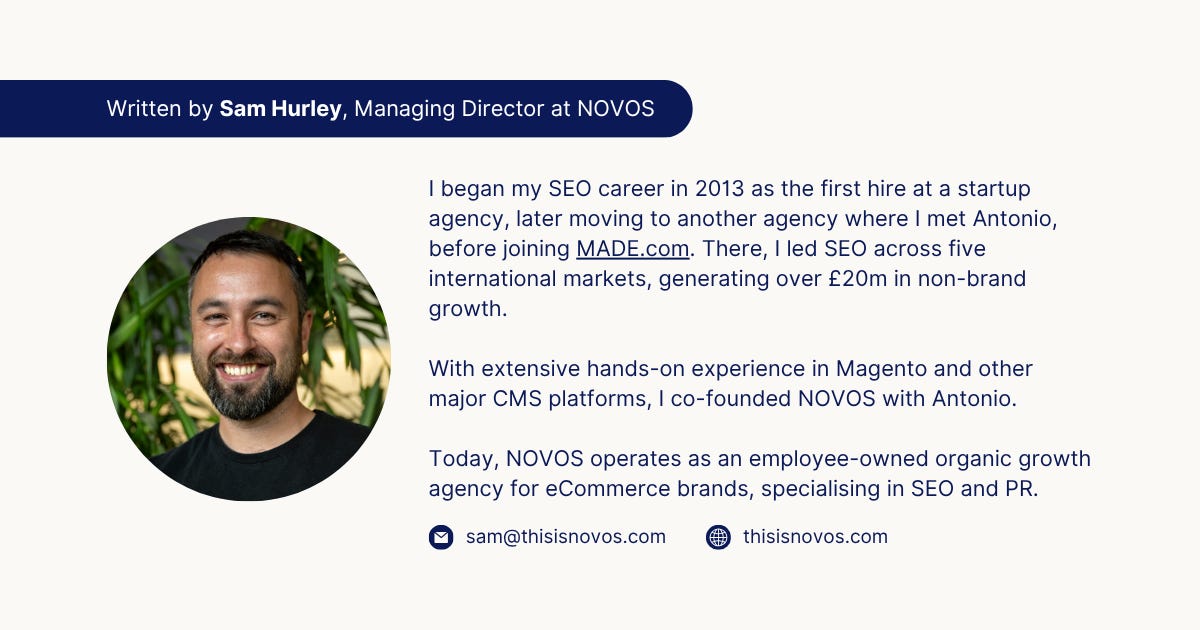Google Outlines the New Era of Search
What Google see's as the next era of search
Last week Google outlined what it see’s as the next era of search.
When people hear “GEO,” they immediately think of ChatGPT or Perplexity. But as we keep reminding our clients and leads - Google AIOs are already here (with AI mode recently in the UK), with a far more sophisticated algorithm. And that’s where the eyeballs and money are right now.
Google is not just a keyword engine. It’s evolving into an AI-powered conversational brain, combining natural language, visual search, and deeper contextual understanding. Robby Stein, Google’s VP of Product for Search, recently laid out this vision - and it has big implications for eCommerce brands, retailers, and creators.
Below is a breakdown of Stein’s framework, followed by what it means in practice for brands in the eCom space and how to prepare.
Quick quote from the podcast:
“The core of Google search isn’t changing… AI is expansionary”
Stein’s Framework: The Three Pillars of AI Search
Robby Stein describes Google’s next-gen search architecture as built on three interlocking pillars.
Stein envisions these three modes merging fluidly — users won’t need to choose “search vs. AI” manually. The system will detect when to deliver a simple AI Overview, or when to launch into AI Mode.
Importantly, this isn’t about replacing “search results” entirely, but evolving how those results are generated and presented. Stein emphasises Google is moving beyond serving just web pages - it wants to generate responses with context, structure, and conversational depth.
What This Means for eCommerce Brands
What does it mean for an eCommerce brand? Below are key implications and action areas:
1. Think beyond “keywords” - align with questions & decisions
In an AI-first interface, users will ask complex, multi-step questions (“Which vacuum works best on pet hair and hardwood floors within £300?”). The system will parse that, fetch data, compare, and answer.
Action: Audit your content and product pages for decision-stage queries (vs. simple product names). For example:
“Compare X vs Y for [use case]”
“Which is better for [condition], X or Y?”
“How to maintain [product] over time”
“Best X for under £XYZ”
Align content depth with filter/attribute depth which align with situations/issues/solutions your customer may be looking for, for example rather than just focusing on content around the topic of ‘leggings’ think about the subcategories and attributes below these e.g.:
Leggings for the gym
High waisted leggings
High waisted leggings for the gym with pockets
2. Make your structured data & product feeds airtight
The “brain” Stein describes leans heavily on Google’s internal graphs: e.g. the Shopping Graph (50 billion products updated continuously).
If your product feed is inaccurate, missing attributes (size, colour, stock, warranties), or out of sync - you risk being misinterpreted, omitted or misrepresented.
Action: Ensure your product schema (JSON-LD / schema.org markup) is clean, complete and updated in real time. Monitor feed errors in Merchant Center constantly.
Ensure your PDP attributes and hard data is as comprehensive as possible, tools like Emfas can help to research and pull these in on mass across PDPs e.g.: see it in action here;
https://www.ellis-brigham.com/scarpa-mens-mescalito-trk-pro-gore-tex-walking-boots-244185903
3. Optimise for citation, not just ranking
In AI Overviews or AI Mode answers, Google will often cite or “source” content. That means even if your page doesn’t appear in the classic top-10, it might still be referenced in an AI response.
Action:
Structure your content to be clear, modular (e.g. short definitions, bullet points)
Use headers that directly match likely question phrases
Cite your claims with sources, data, or internal/external references
Consider including “answer boxes” or summary modules that are easily digestible
Invest in offsite citation building to maintain a competitive advantage and get coverage on sites LLMs and Google see as reputable
4. Embrace visual & video content as part of search
Because search is becoming multimodal, visuals carry more meaning. Image search, Lens, and AI Mode could surface your product images or how-to visuals directly.
Action:
Invest in high-quality product visuals, annotated images, and explainer videos
Use descriptive alt text, structured captions, and markups to help Google index image content (AI tools can generate alt text on mass too)
Include “how-to / unboxing / comparison” videos embedded in product or category pages
Source on YouTube and leverage product tagging
5. Support conversational paths & follow-ups
AI Mode isn’t just a static answer — it expects to allow follow-up queries (“Wait, what about price difference?” or “Show me reviews?”) If your content supports that “conversation,” it’s more likely to be surfaced.
Action: Map out the likely “threads” a user might take (first question → follow-up → deeper drill-down). Then structure your content (or “related questions / internal links”) to accommodate those paths.
In the SEO world we call this query fan out analysis https://www.semrush.com/blog/query-fan-out/
6. Monitor “AEO / GEO / IEO” but don’t abandon SEO fundamentals
When it comes to GEO, AEO, GXO or whatever you want to call it this week - Stein suggests that while the interface is changing, the fundamentals still matter - authority, intent matching, originality, trust.
Action:
Don’t ditch keyword strategy — continue mapping high-intent keywords but consider them as part of the overall customer journey
Invest in brand authority, backlinks, and domain strength
Continually test and iterate content for usefulness, clarity, and freshness
This is the topic of an upcoming Substack post. In the SEO world “GEO” isn’t really a thing / it’s accepted it’s just SEO. However, in the eCommerce world, GEO is sticky and won’t go away. Join us as we conduct a deep dive to give you an idea of how we see this working together or where “GEO” fits in vs. “SEO”.
Sample Structure for a Product Page in the AI Era
Here’s a suggested layout to better integrate into AI-driven search:
Headline / question
Short summary answer
Key comparison table
Sections for likely follow-ups
User FAQs (phrased as natural questions)
Visuals / annotated images / short video - including UGC
Product reviews
Calls to action or comparison to alternatives
If your content frequently aligns with how AI will parse and respond, there’s a better chance it’s surfaced within the AI responses even when it might not dominate traditional SERPs.
Final Thoughts & Next Steps
The shift Stein describes is structural - not just aesthetic. Search is transforming from a list of links into a conversational information layer layered over Google’s knowledge graph, shopping data, and web content.
For eCommerce brands, that means being proactive: aligning content with queries and decisions, enriching structural data and visuals, and supporting deeper conversational threads. We outlined this a few weeks back here, where we are using persona’s more than ever for AI strategies: https://ecommerce.thisisnovos.com/p/situational-search-how-to-get-your?r=2qo9mq.
Sources and deeper reading:
Want to stay in the loop? Subscribe here for more.







Thanks for writing this, it clarifies a lot about Google's direction and Robby Stein's framework. I'm curious about the 'detection' mechanism for switching between AI Overview and AI Mode; it sounds sophisticated, but I wonder how it navigates the potential for introducing new biases verus maintaining search result neutrality.